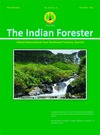Estimation of Standing State Biomass and Carbon Sequestration Potential of Multipurpose Tree Species at Mohand Range, Dehradun Forest Division, Uttarakhand
DOI:
https://doi.org/10.36808/if/2016/v142i11/105603Keywords:
Biomass, Carbon Sequestration, Multi-Purpose Trees, Acacia nilotica, Albizzia lebbeck, Dalbergia sissoo, Eucalyptus tereticornis and Terminalia arjuna.Abstract
The present study was carried out on 24-yr-old five multipurpose tree species viz, Acacia nilotica (L.) Delile, Albizzia lebbeck (L.) Benth., Dalbergia sissoo D.C., Eucalyptus tereticornis Sm. and Terminalia arjuna (Roxb. ex. DC.) Wight&Arn. with an objective to estimate above ground biomass and carbon sequestration potential at Mohand range, Dehradun Forest Division, during 2011-2012. Aboveground biomass production was observed to be maximum in Eucalyptus tereticornis (827.12 kg /tree) and the minimum was in Terminalia arjuna (450.80 kg/tree). Results of fixed carbon percentage showed Albizzia lebbeck and Dalbergia sissoo as most suitable multipurpose tree species. The maximum fixed carbon content or carbon storage per cent was observed in Albizzia lebbeck (56.68%) while minimum was in Eucalyptus tereticornis (48.75%). The maximum amount of carbon sequestered was recorded in Eucalyptus tereticornis (403.40 kg/tree) and the lowest was n Terminalia arjuna (248.45 kg/tree). It was recorded that the amount of carbon dioxide sequestered was highest in Eucalyptus tereticornis (1478.85 kg/tree), whereas, the lowest amount was recorded in Terminalia arjuna (910.83 kg/tree).References
Babu M.M. (2011). Effect of different pruning intensities and doses of fertilizers on the growth and productivity of wheat under agrisilviculture (Shisham+Wheat) practice. MSc. Thesis, JNKVV, Jabalpur. pp. 30-45.
Brown S. (1997). Estimating biomass and biomass change of tropical forests: A premier FAO forestry paper, 134, FAO, Rome.
Chaturvedi A.N and Khanna L.S. (1982). Forest Mensuration. International Book Distributors, Rajpur Road, Dehradun
Chauhan S.K., Gupta N., Ritu Yadav S. and Chauhan R. (2009). Biomass and Carbon Allocation in Different parts of agroforestry tree species. Indian Forester, 135(7): 981-993.
Dhruv S.K., Singh L. and Singh A.K. (2009). Storage and sequestration of carbon by leguminous and non-leguminous trees on red lateritic soil of Chhattisgarh. Indian Forester, 135(4): 531-538.
Dixon R.K., Brown S., Houghton R.A., Soloman A.M., Trexler M.C. and Wisniewski J. (1994). Carbon pools and flux of global forest ecosystems. Science, 263: 185-190.
Ganeshaiah K.N., Barve N., Nath N., Chandrashekara K., Swamy M. and Shaanker R.U. (2003). Carbon allocation in different components of some tree species of India: A new approach for carbon estimation. Current Science, 85(11): 1528-1531.
Gomez K.A. and Gomez A.A. (1984). Statistical procedures for agricultural research (2nd edn.). John Wiley and Sons, Inc. New York.Pp 680.
IPCC (1999). Inter Governmental panel on climate change- Report on land use change and forestry (Watson, R.T., Noble, L., Bolin, B. and Ravindranath, N.H.). Government Publishing Service, Canberra, Australia. Pp.79.
Jana B.K., Biswas S., Majumder M., Roy P.K. and Mazumdar A. (2009). Carbon sequestration rate and above ground biomass carbon potential of four young species. J. Ecology and Natural Environment, 1(2): 15-24.
Kaur B., Gupta S.R. and Singh G. (2002). Carbon storage and nitrogen cycling in silvopastoral system on a sodic soil in Northern- Western India. Agroforestry Systems, 54: 21-29.
Kraenzel M., Castillo A., Moore T. and Potvin C. (2003). Carbon storage of harvest age-teak (Tectona grandis) plantations, Panama. Forest Ecology and Management, 173: 213-225.
Kunhamu T.K., Kumar B.M. and Syam V. (2005). Tree allometry, volume and above ground biomass yield in a seven-year-old Acacia mangium. willd stand at Thiruvazhamkunnu, India. Proceeding of the international conference on multipurpuse trees in the tropics: Assessment, Growth and Management. Arid Zone Forest Research Institute, Jodhpur, 22- 25 November, 2004. Multipurpuse trees in the Tropics: Management and improvement strategies.2006. Scientific publishers, Jodhpur. Pp. 415-421.
Lorenz K. and Lal R. (2010). Carbon Sequestration in Forst Ecosystems. Springer, Dordrecht, the Netherlands.
Lugo A., Wang D. and Bormann H. (1990).A comparative analysis of biomassproduction in five tree species. Forest Ecology and Management, 31: 153-166.
Mani S. and Parthasarathy N. (2007). Above-ground biomass estimation in ten tropical dry evergreen forest sites of peninsular India. Biomass and Bioenergy, 31: 284-290.
Montagnini F. and Porras C. (1998). Evaluating the role of plantations as carbon sinks: An example of an integrative approach from the humid tropics. Environment Management, 22(3): 459-470.
Norris M.D., Blair J.M., Johnson L.C. and Makane R.B. (2001). Assessing change in biomass productivity and C and N stores following Junipenisvirginiana forest expansion into tall grass prairie. Canadian J. Forest Research, 31: 1940-1946.
Puri S., Swamy S.L. and Jaiswal A.K. (2002). Evaluation of Populus deltoides clones under nursery, field and agriculture system in sub-tropics of Central India. New Forests, 23: 45-61.
Swamy S.L., Mishra Y.A. and Puri S. (2003). Biomass production and root distribution of Gmelinaarborea under an agri-silviculture system in sub humid tropics of Central India. New Forests, 26: 167-186.
Zobel B.J. and Tabert J. (1984). Applied tree improvement. John Wiley & Co., New York, USA. Pp 503.
Downloads
Downloads
Published
How to Cite
Issue
Section
License
Unless otherwise stated, copyright or similar rights in all materials presented on the site, including graphical images, are owned by Indian Forester.





